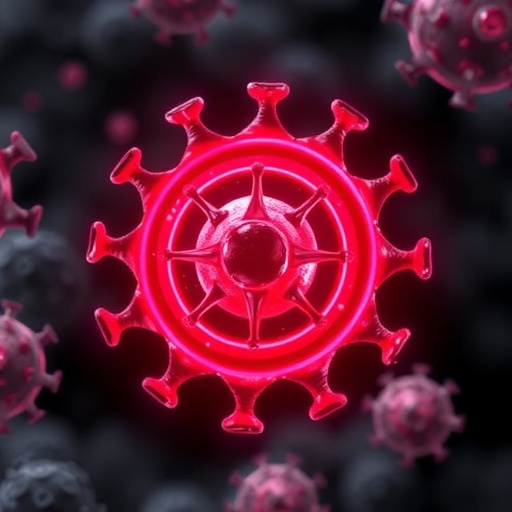In recent years, the fight against infectious diseases caused by parasites has grown more complex, with researchers constantly seeking innovative solutions. One of the most challenging of these diseases is leishmaniasis, caused by the protozoan parasite Leishmania. Traditional treatments have proven to be not only expensive but also accompanied by significant side effects and issues of resistance. This is where a groundbreaking study by Verdan et al. enters the limelight, introducing AMF-responsive nanobiomagnetite nanoparticles for the targeted delivery of amphotericin B specifically against Leishmania amazonensis, marking a pivotal advancement in the quest for effective leishmaniasis therapies.
Amphotericin B has long been a cornerstone of leishmaniasis treatment; however, its systemic administration can lead to toxicity and adverse health effects. As such, the necessity for delivering this potent antifungal agent directly to infected tissues has become evident. In the study led by Verdan and colleagues, the researchers investigated the potential of utilizing AMF (alternating magnetic fields) to enhance the localization and effectiveness of amphotericin B. Unlike conventional treatment methods that circulate the drug throughout the body, the introduction of nanobiomagnetite allows for targeted therapy, minimizing side effects while maximizing therapeutic action.
Nanobiomagnetite represents a new frontier in drug delivery systems. The nanoparticles interact favorably with the magnetic field generated by AMF, enabling them to be guided towards the leishmania-infected areas. This novel approach not only increases the concentration of the drug at the target site but also reduces the required dosage by allowing for localized delivery. Consequently, the risk of systemic toxicity is significantly diminished. The researchers meticulously discuss tailored physicochemical properties of these nanoparticles to optimize their function in transporting the drug.
Moreover, the study emphasizes the encapsulation capabilities of these nanoparticles, which can effectively shield amphotericin B against degradation and enhance its stability. The nature of the nanobiomagnetite ensures a controlled release of the antifungal agent, achieved by modulating the exposure to the AMF. Such deliberation on timing and dosage is crucial as it can allow for sustained therapeutic levels while mitigating peaks that might lead to adverse effects.
Leishmania amazonensis, a particular species of Leishmania, was chosen for this investigation due to its prevalence and significance in public health. Targeting this pathogen is crucial, especially in endemic regions where the disease imposes a socioeconomic burden. The products of the new delivery system have shown promising results in preliminary tests, demonstrating increased effectiveness in combating this parasitic infection.
One striking aspect of this study is the association of magnetic targeting with biocompatible materials. This attribute adds to the safety profile of the nanobiomagnetite system and provides a dual-functionality that potentially outperforms previous methods. As more pathogens develop resistance to standard treatments, researchers aim for solutions that blend efficacy with minimal health implications, and this innovative system appears to meet this need adequately.
The implications of this research extend beyond just leishmaniasis. The methodologies and technologies developed here could potentially be adapted for other vector-borne diseases, thus broadening the impact on global health. After all, the challenges that arise from drug resistance and the intricacies of treating parasitic infections demand a versatile approach.
Furthermore, potential implications can also be observed in how this technology interacts with the immune system. The delivery of amphotericin B in this novel format may offer the additional benefit of modulating the host’s immune response. By drawing attention to the site of infection, the nanoparticles may not only fight off the pathogen but also improve the overall immune response, rendering it more robust.
Ultimately, the research conducted by Verdan et al. heralds a new chapter in the management of leishmaniasis and possibly other parasitic diseases. The innovation of AMF-responsive nanobiomagnetite for the targeted delivery of a well-established drug exemplifies the importance of interdisciplinary research, combining materials science, pharmacology, and infectious disease expertise, to forge new paths toward effective treatments.
In conclusion, the strides made in this study encapsulate the essence of modern scientific inquiry: addressing fundamental problems with novel solutions. As the world continues to grapple with various infectious diseases, the potential of nanotechnology in drug delivery systems paves the way for a future where targeted therapies can become the norm. The road ahead involves continued research, clinical trials, and a commitment to overcoming the obstacles associated with parasitic infections.
The journey initiated by Verdan et al. brings a beacon of hope not only for combating Leishmania amazonensis but also for enhancing therapeutic strategies across a spectrum of infectious diseases.
Subject of Research: Targeted delivery of amphotericin B using AMF-responsive nanobiomagnetite against Leishmania amazonensis.
Article Title: AMF-responsive nanobiomagnetite for targeted delivery of amphotericin B against Leishmania amazonensis.
Article References:
Verdan, M., Nico, D., Sangenito, L. et al. AMF-responsive nanobiomagnetite for targeted delivery of amphotericin B against Leishmania amazonensis. Sci Rep 15, 39994 (2025). https://doi.org/10.1038/s41598-025-23720-6
Image Credits: AI Generated
DOI: https://doi.org/10.1038/s41598-025-23720-6
Keywords: Leishmania, amphotericin B, nanobiomagnetite, drug delivery, targeted therapy, AMF, infectious diseases.
Tags: advancements in parasitic disease treatmentsAMF-responsive drug deliveryamphotericin B for leishmaniasisantifungal agents in infectious diseasesinnovative leishmaniasis therapiesLeishmania amazonensis treatmentlocalized drug administrationmagnetic field drug targetingnanobiomagnetite nanoparticlesnanoparticle-based therapiesreducing side effects in treatmenttargeted drug delivery systems




